北师大模块六Unit_16_Lesson1_Pompeii教案
- 格式:doc
- 大小:34.50 KB
- 文档页数:4

Unit 16 StoriesMyhusbandhasn’tstoppedlaughingaboutafunnythingthathappenedtome.It’sfunnyno wbutitwasn’tatthetime.LastFriday,afterdoingallthefamilyshoppingintown,Iwantedarestbeforecatchingthetrain,soIboughtanewspaperandsomechocolateandwentintothestationcoffeeshop—thatwasachea pself-serviceplacewithlongtablestositat.Iputmyheavybagdownonthefloor,putthenewspaperandchocolateonthetabletokeepaplace,andwenttogetacupofcoffee.WhenIwentbackwiththecoffee,therewassomeoneinthenextseat.Itwasoneofthosewild-lookingyoungsters,withdarkglassesandwornclothes,andhaircoloredbrightredatthefront.Notsounusualthesedays.Whatdidsurprisemewasthat he’dstartedtoeatmychocolate!Naturally,Iwasannoyed.However,toavoidtrouble,Ijustlookeddownatthefrontpageofthenews-paper,tastedmycoffeeandtookabitofchocolate.Theboylookedatmeclosely.Thenhetookasecondpi eceofmychocolate.Icouldhardlybelieveit.StillIdidn’tdaretostartanargument.Whenhe tookathirdpiece,Ifeltmoreangrythanuneasy.Ithought,“Well,Ishallhavethelastpiece.”AndIgotit.Theboygavemeastrangelook,andthenstoodup.Asheleftheshoutedout,“Thiswoman’scrazy!”Everyonestared.Thatwasembarrassing(令人尴尬的)enough,butitwasworsewhenIfinishedmycoffeeandgotreadytoleave.Myfacewentred—asredashisha ir—whenIrealizedI’dmadeamistake.Itwasn’tmychocolatethathe’dbeentaking.Therew asmine,unopened,justundermynewspaper.阅读短文,判断正(T)误(F)1.Seeingtheboyeatingherchocolatemadetheauthorsurprisedwhenshereturnedtoherseat.( T)2.Theauthor’sfaceturnedredbecausesherealizedthattheboywaspoorandangry.(F)Period One Warm-up & Lesson 1 Stories fromHistory—Pre-reading匹配左边的单词与右边的汉语意思[第一组]1.biography A.保护,保存2.abandon B.传记3.victim C.(评判的)标准4.criteria D.放弃,遗弃5.preserve E.受害者答案 1.B 2.D 3.E 4.C 5.A[第二组]6.witness A.颤抖,发抖7.occur B.特别地;特定地8.tremble C.发生9.particularly D.遗失,丢失10.loss E.目击答案 6.E 7.C 8.A 9.B 10.D[第三组]11.awesome A.典型的12.rewind B.建筑13.architecture C.倒回14.authentic D.令人敬畏的15.characteristic E.原作的;真正的答案11.D 12.C 13.B 14.E 15.A[第四组]16.monument A.聚集17.gather B.纪念碑,纪念堂18.sorrow C.同情19.sympathy D.爆炸;冲,闯20.burst E.悲伤,难过答案16.B 17.A 18.E 19.C 20.DStep1Fast-reading1.What’sthemainideaofthepassage?A.It’saboutthestoryofthecityofPompeii.B.It’sabouttheancientarchitecturesofRome.C.It’sabouttheeffectsofthevolcaniceruption.D.It’saboutanimportanthistoricaldiscovery.答案 A2.Readthetextandmatchthemainideaofeachparagraph.Para.1 A.Whattheeruptionbroughttopeople.Para.2B.PeopleimaginewhatthepeopleinPompeiiweredoingwhentheyfacedthedisaster. Para.3C.WhatPompeiilookedlikebeforethevolcaniceruption.Para.4D.TheCityofPompeiilivesonnearly2,000yearsafteritsloss.Para.5E.ScientistsdiscoveredthecityofPompeii.Para.6F.Thebackgroundknowledgeofthevolcaniceruption.答案Para.1:F Para.2:A Para.3:E Para.4:CPara.5:B Para.6:DStep2Careful-readingReadthepassagecarefullyandchoosethebestanswer.1.WhyisPompeiilikea“timecapsule”?A.Becausethecityisamonumenttohumanhistory.B.Becausethecitycankeepthemomentfrozen.C.Becausethevolcaniceruptionpreservedbuildings,objectsandevenimpressionsofpeoplefromthetime.D.Becausetheboomingcitywasdestroyedbythevolcaniceruption.答案 C2.WhichstatementisTRUEaccordingtothepassage?A.Beforetheeruptionoccurred,PompeiihadbeenanordinaryRomancity.B.1,600yearslater,somescientistsfoundthelostRomantowns.C.Plinywitnessedthevolcaniceruptionasachild.D.Theeruptionburiedeverythinginitspath,includingwholevillagesandtowns.答案 D3.YoumayfeelwhenyouseethebodiesofpeoplewhohaddiedinPompeii.A.unbelievableB.ridiculousC.puzzledD.sorrowanddeepsympathy答案 D4.ThescientistsfoundthecityofPompeiiinthecentury.A.18thB.19thC.20thD.21st答案 A5.ItisthathavemadethecityofPompeiiamonumenttohumanhistory.A.thevolcaniceruptionB.theancientarchitectureandstatuesC.thedecoratedwallsandauthenticobjectsD.theformsofthepeoplewhowerecaughtinthedisaster答案 DStep3Post-readingAfterreadingthepassage,pleasefillinthefollowingblanks.StoriesfromHistoryAroundtheendofthefirstcenturyAD,aRomanwriter1.called(call) Plinywroteaboutavolcaniceruptionthathehadwitnessed2.asayoungman.Theeruptionhadoc curredonAugust24th,79AD.Thetragedyevenleftadeep3.impression(impress) onPlinywhohadlostanuncleintheevent.4.However,morethan1,600yearslater,somescientists5.started(start) uncoveringthelosttownsthat6.wereburied(bury) undertheashesofMountVesuvius.Inaway,Pompeiiislikea“timecapsule”7.preserving(preserve)afrozenmomentinhistory.Beforetheeruptionoccurred,8.ithadbeenaprosperousRomancity withtemples,markets,restaurantsandtheatres.Todayyoucanvisitthesebuildingsby9.walking(walk) alongtheoriginalstreetsofthecity.Andmorethan250yearssinceexcavationstarted,thousandsoftouristsandhundredsofscientistsvisitPompeiieveryyeartolearn10.more(mu ch) abouttheancientworld.Step4Sentence-learning1.AroundtheendofthefirstcenturyAD,aRomanwritercalledPlinywroteaboutaterriblevolcaniceruptionthathehadwitnessedasay oungman.[句式分析]本句是一个复合句,AroundtheendofthefirstcenturyAD是时间状语;calledPliny是过去分词短语作后置定语;that引导定语从句,修饰eruption。
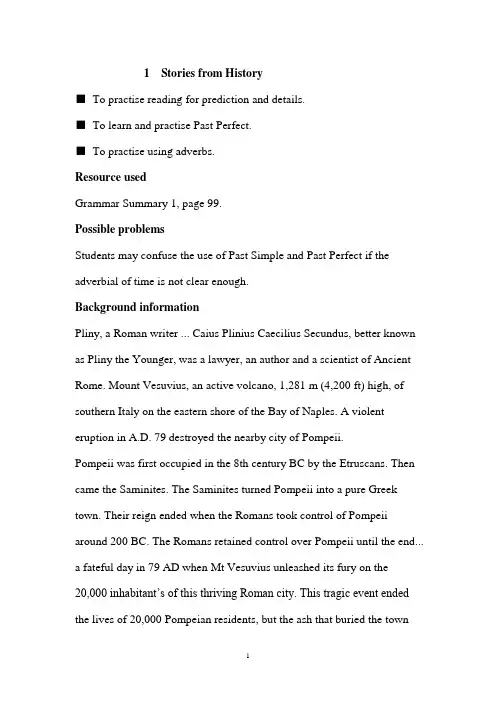
1 Stories from History■To practise reading for prediction and details.■To learn and practise Past Perfect.■To practise using adverbs.Resource usedGrammar Summary 1, page 99.Possible problemsStudents may confuse the use of Past Simple and Past Perfect if the adverbial of time is not clear enough.Background informationPliny, a Roman writer ... Caius Plinius Caecilius Secundus, better known as Pliny the Younger, was a lawyer, an author and a scientist of Ancient Rome. Mount Vesuvius, an active volcano, 1,281 m (4,200 ft) high, of southern Italy on the eastern shore of the Bay of Naples. A violent eruption in A.D. 79 destroyed the nearby city of Pompeii.Pompeii was first occupied in the 8th century BC by the Etruscans. Then came the Saminites. The Saminites turned Pompeii into a pure Greek town. Their reign ended when the Romans took control of Pompeii around 200 BC. The Romans retained control over Pompeii until the end...a fateful day in 79 AD when Mt Vesuvius unleashed its fury on the20,000 inhabitant’s of this thriving Roman city. This tragic event ended the lives of 20,000 Pompeian residents, but the ash that buried the townserved as a sort of mummification for the entire city. The eruption of 79 AD which buried the town in ash actually captured a moment in time. Under the ash everything remained as it was at the time of the eruption. Artwork was preserved. Buildings were preserved. Several important clues were left behind. These clues give us a little glimpse into the past. These clues are the silver lining that can be seen when you visit the ruins at Pompeii.Routes through the material. If you are short of time, set some of the exercise for homework (e.g. Exercise 8).. If you have two periods for this lesson, a suitable natural break is after Exercise 4.ReadingBefore you startExercise 1■Provide contexts for students to work out the meaning of the Key Words in the box.■Encourage students to predict what the text is about by skimming the picture, the Key Words and the title. Elicit more from those who have already known about it.Key wordsvolcanic eruption, buried, event , disappear, disaster, preserved, destroy, discover, scientistRead to learnExercise 2■Have students read the text to check their prediction.■Students read the text a second time to find the answers to the questions.■Students compare their answers in pairs before checking them as a class.■Encourage students to work out meaning of more words through the context:witness― to see and experience important events or changesoc cur― to happenblock out ― to stop light reaching a placeThere was a heavy curtain blocking out the light.Preserve ― to save something or someone from being harmed or destroyedWe must encourage the planting of new trees and preserve our existing woodlands.be caught in ―to be in a situation that you cannot easily get out of We got caught in a rainstorm on the way here.live on ― to continue to live or exist$35,000 a year sounds like a lot of money, but it’s scarcely enough to live on in New York.。
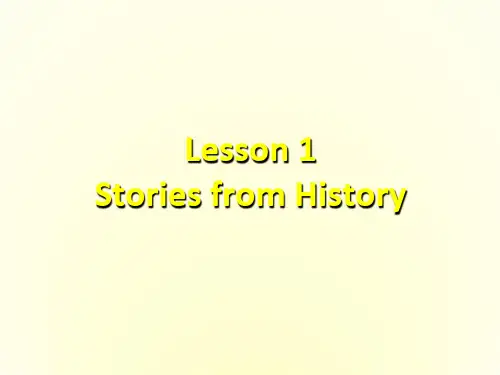
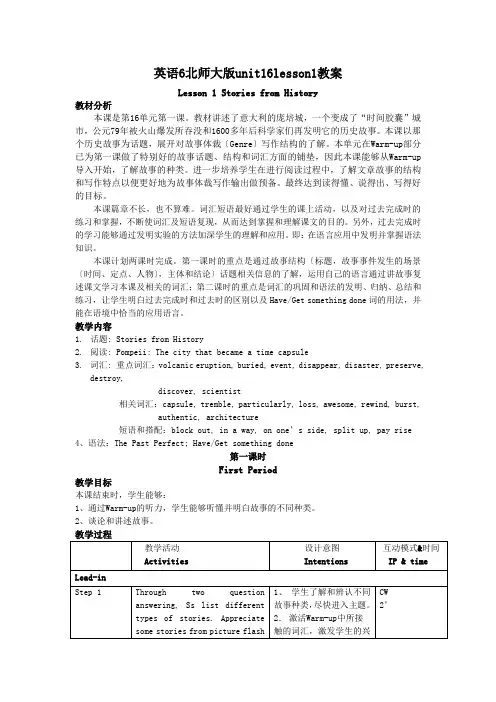
英语6北师大版unit16lesson1教案Lesson 1 Stories from History教材分析本课是第16单元第一课。
教材讲述了意大利的庞培城,一个变成了“时间胶囊”城市,公元79年被火山爆发所吞没和1600多年后科学家们再发明它的历史故事。
本课以那个历史故事为话题,展开对故事体裁〔Genre〕写作结构的了解。
本单元在Warm-up部分已为第一课做了特别好的故事话题、结构和词汇方面的铺垫,因此本课能够从Warm-up 导入开始,了解故事的种类。
进一步培养学生在进行阅读过程中,了解文章故事的结构和写作特点以便更好地为故事体裁写作输出做预备。
最终达到读得懂、说得出、写得好的目标。
本课篇章不长,也不算难。
词汇短语最好通过学生的课上活动,以及对过去完成时的练习和掌握,不断使词汇及短语复现,从而达到掌握和理解课文的目的。
另外,过去完成时的学习能够通过发明实验的方法加深学生的理解和应用。
即:在语言应用中发明并掌握语法知识。
本课计划两课时完成。
第一课时的重点是通过故事结构〔标题,故事事件发生的场景〔时间、定点、人物〕,主体和结论〕话题相关信息的了解,运用自己的语言通过讲故事复述课文学习本课及相关的词汇;第二课时的重点是词汇的巩固和语法的发明、归纳、总结和练习,让学生明白过去完成时和过去时的区别以及Have/Get something done词的用法,并能在语境中恰当的应用语言。
教学内容1.话题: Stories from History2.阅读: Pompeii: The city that became a time capsule3.词汇: 重点词汇:volcanic eruption, buried, event, disappear, disaster, preserve,destroy,discover, scientist相关词汇:capsule, tremble, particularly, loss, awesome, rewind, burst, authentic, architecture短语和搭配:block out, in a way, on one’s side, split up, pay rise4、语法:The Past Perfect; Have/Get something done第一课时First Period教学目标本课结束时,学生能够:1、通过Warm-up的听力,学生能够听懂并明白故事的不同种类。
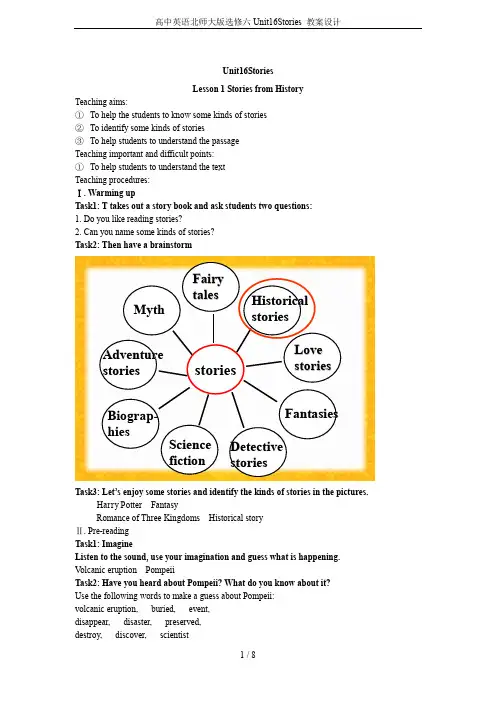
Unit16StoriesLesson 1 Stories from HistoryTeaching aims:① To help the students to know some kinds of stories ② To identify some kinds of stories③ To help students to understand the passage Teaching important and difficult points: ① To help students to understand the text Teaching procedures: Ⅰ. Warming upTask1: T takes out a story book and ask students two questions: 1. Do you like reading stories?2. Can you name some kinds of stories? Task2: Then have a brainstormstoriesFairy talesDetective storiesLove stories FantasiesHistorical storiesBiograp-hiesScience fictionAdventure stories MythTask3: Let’s enjoy some stories and ident ify the kinds of stories in the pictures. Harry Potter FantasyRomance of Three Kingdoms Historical story Ⅱ. Pre-reading Task1: ImagineListen to the sound, use your imagination and guess what is happening. V olcanic eruption PompeiiTask2: Have you heard about Pompeii? What do you know about it? Use the following words to make a guess about Pompeii: volcanic eruption, buried, event, disappear, disaster, preserved, destroy, discover, scientistⅢ. ReadingTask1: Listen and read to get the main idea of the passage:It is about a city named Pompeii , which was buried by a volcanic eruption and discovered again by some scientists 1,600 years later.Task2: Second reading:Task3: Sum up: fill in the blanksPliny was a Roman writer who had _________ and wrote about a _________ eruption which ________ on August 24th,79AD and it was of Mt. Vesuvius. The tragedy had left a deep __________ on Pliny whose uncle died in the event. The whole towns and villages were _________ by the ashes of Mt Vesuvius. By 1748, scientists started to ________the ancient city Pompeii. It is like a “time capsule” __________a frozen moment in history. Not only the buildings and objects of Pompeii attract the people, but also the forms of the people caught in the _______ that made the city a __________ to human history. The bodies of people died in Pompeii showed their exact _______of getting together for_________. Today, since excavations started, people and scientists visit Pompeii every year to learn more about the ______________. In this way, the city __________ nearly 2,000 years after its ________.Ⅳ. Post-readingDiscussion:What natural disasters do you know?If you meet one of them, what will you do?Ⅴ. Assignments:1.Read the text again and find out some useful words and expressions.2. Finish the exercise3&4 in Page6-7Lesson 2 Name StoriesTeaching Aim:①.Learn to talk about the origin and hidden story behind one’s name.②. Learn to make suggestions, assumptions and guesses.③ Help to improve students’ listening skillsTeaching difficult and important points①.talk about the origin and hidden story behind one’s name②.improve students’ listening skillsTeaching procedures:Ⅰ. Warming upLook at the pictures of Jackie Chan and Sun Yet-sun then ask students:Who is he?What about his Chinese name?What about his original Chinese name?Task1:①.Compared their Chinese names, do you know the history of their name. Why did they change their name?②. Do their name have any specific meanings?His original name was Chen Gangsh(陈港生),which tells his birthplace. In his acting career, he first had a stage name(艺名)Chen Yuanlong(陈元龙). Later, a film director gave him another stage name Chenglong(成龙), which has two aspects of meanings: the first one is to express the director’s wish that Cheng could become famous, just like a dragon- the symbol of China; the second it is hoped that Cheng would follow the example of another well-known Chinese martial star(功夫明星), Li Xiaolong(李小龙).Ⅱ. Speaking. Work in pairs.1. What’s your name?2. What does it mean?3. And why did your parents give you the name?Ⅲ. Listening.Task1: Listen to the three students talking about their names. Which of them matches the following descriptions?1. This student has parents who wanted their child to be a “pillar of societ y”.( )2.This student has a grandfather who migrated from northern Wales to Manchester.( )3. This student probably has an ancestor who made things from metal. ( )4. This student has parents who were inspired by a great violinist Itzhak Perlman. ( )5. This student is named a purple flower.( )6. This student has parents who wanted their daughter to be as strong and capable as any boy.( )Taks2: Function fileListen to the extracts from the monologues and complete the Function File.Expressing guesses, assumptions, beliefsⅣ. ReadingTask1: Let’s read a name storyComplete the passage with these phrasal verbs, exercise 5Task2: Culture LinkingWestern namesApart from their surname or last name or family name in Britain or the US, most British and American children are given two personal names by their parents, a first name and a middle name. These names are sometimes called Christian names or given names. Some people have only one given name, a few have three or more.Parents usually decide on given names for their children before they are born. In some families the oldest boy is given the same name as his father. In the US the word junior or senior, or a number, is added after the name and surname to make it clear which person is being referred to.Many popular names come from the Bible, e.g. Jacob, Joshua and Matthew, Mary, Rebecca and Sarah, though this does not imply that the people who choose them are religious. Other people give their children the name of somebody they admire, such as a famous sports personality, or a film or pop star. In Britain the names William and Harry have become common again since the sons of Prince Charles were given these names.Ⅴ. AssignmentsLesson 3 Life StoriesTeaching Aim:① Learn some useful reading strategy: predicting, general idea, and working out the meaning of important words from the context.②. Learn to retell a story according to time order③. Accumulate some synonyms and antonymsTeaching important and difficult points①.Learn some useful reading strategy②.Retell a story according to time orderTeaching procedures:Ⅰ. Warming upTask1: Look at the picture and talk something about Helen KellerTask2:Talk about some famous people and their eventsⅡ. Pre-readingIntroduction about Helen KellerHelen Keller (June 27, 1880 - June 1, 1968), was an author, lecturer, and humanitarian whose unusual life and dedicated 献身的work had an international influence on the lives of the disabled (残疾人). She became blind and deaf at the age of 19 months through a damaging brain fever and could communicate only through hysterical 歇斯底里laughter or violent tantrums 发怒. But, with the help of her teacher Anne Mansfield Sullivan, Keller learned to read barilla盲文and to write by using a special typewriter. Bibliography自传: Keller, Helen, The Story of My Life and Teacher (1955); Waite, H. E., Valiant Companions: Helen Keller and Anne Sullivan Macy (1959);Ⅲ. ReadingTask1: Reading strategy (1)Before reading, look at the title, pictures and the first couples of lines of the text.Look for clues to help you predict what kind of text it is and what it is about.Reading strategy(2)Read the text to get the general idea. Ignore words you don’t know.Read the text again. Try to work out the meaning of important new words. Use a dictionary if you can’t.Read any comprehensive questions and try to think of possible answers. Then find answers to questions in the text.Task2: read the text and answer the following questions:1. How was Helen Keller different from other children?2. Why was her teacher so important to her?3. How did she learn new words?4. Why did she feel happy when she understood the meaning of the word “water”?5. Why was the word “love” so difficult for Helen to understand?6. Why did she think that love might be the sun?7. How did she learn the word “think”?8. What do the words “love” and “think” have in common?Task3: retell the story according to the cluesCan you figure out the whole process of Helen’s learning ?Some of the clues are given here:①. getting to know Sullivan …getting②. to know some words which can be touched…③.the mystery of language was revealed to her …④.getting to understand some abstract words.Ⅳ. Post-readingDiscussion:What kind of teacher do you think Anne Sullivan is?Try to use as many adjective words as you can:Ⅴ. Language points:1.feel +名词,感到某事情感或触摸到某物。
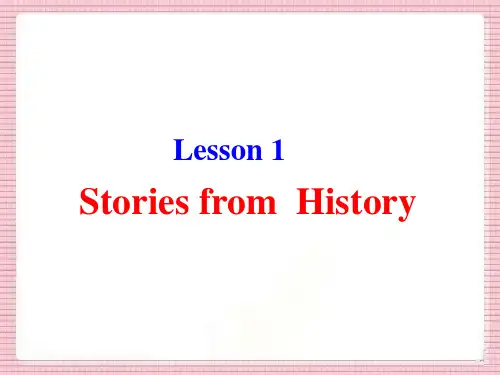
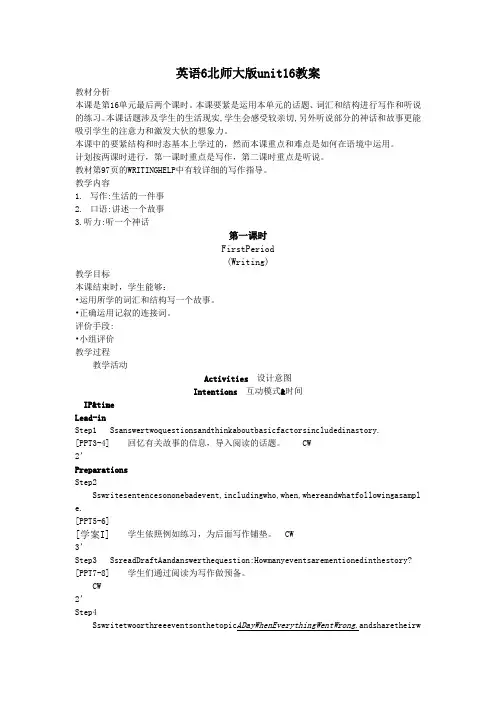
英语6北师大版unit16教案教材分析本课是第16单元最后两个课时。
本课要紧是运用本单元的话题、词汇和结构进行写作和听说的练习。
本课话题涉及学生的生活现实,学生会感受较亲切,另外听说部分的神话和故事更能吸引学生的注意力和激发大伙的想象力。
本课中的要紧结构和时态基本上学过的,然而本课重点和难点是如何在语境中运用。
计划按两课时进行,第一课时重点是写作,第二课时重点是听说。
教材第97页的WRITINGHELP中有较详细的写作指导。
教学内容1.写作:生活的一件事2.口语:讲述一个故事3.听力:听一个神话第一课时FirstPeriod(Writing)教学目标本课结束时,学生能够:•运用所学的词汇和结构写一个故事。
•正确运用记叙的连接词。
评价手段:•小组评价教学过程教学活动Activities设计意图Intentions互动模式&时间IP&timeLead-inStep1 Ssanswertwoquestionsandthinkaboutbasicfactorsincludedinastory.[PPT3-4] 回忆有关故事的信息,导入阅读的话题。
CW2’PreparationsStep2Sswritesentencesononebadevent,includingwho,when,whereandwhatfollowingasampl e.[PPT5-6][学案I]学生依照例如练习,为后面写作铺垫。
CW3’Step3 SsreadDraftAandanswerthequestion:Howmanyeventsarementionedinthestory? [PPT7-8] 学生们通过阅读为写作做预备。
CW2’Step4Sswritetwoorthreeeventsonthetopic ADayWhenEverythingWentWrong.andsharetheirwritingsinpairs.[PPT9][学案II]学生确定写作素材并通过分享丰富写作素材。
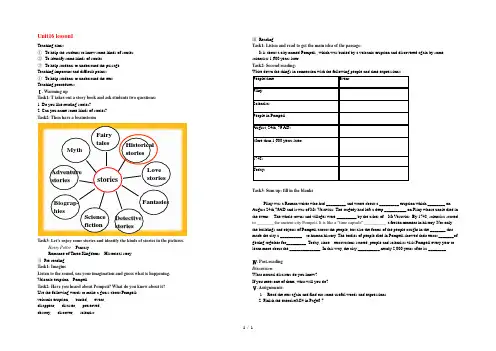
1 / 1Unit16 lesson1Teaching aims:① To help the students to know some kinds of stories ② To identify some kinds of stories③ To help students to understand the passage Teaching important and difficult points: ① To help students to understand the text Teaching procedures: Ⅰ. Warming upTask1: T takes out a story book and ask students two questions: 1. Do you like reading stories?2. Can you name some kinds of stories? Task2: Then have a brainstormstoriesFairy talesDetective storiesLove stories FantasiesHistorical storiesBiograp-hiesScience fictionAdventure stories MythTask3: Let’s enjoy some stories and identify the kinds of stori es in the pictures. Harry Potter FantasyRomance of Three Kingdoms Historical story Ⅱ. Pre-reading Task1: ImagineListen to the sound, use your imagination and guess what is happening. V olcanic eruption PompeiiTask2: Have you heard about Pompeii? What do you know about it? Use the following words to make a guess about Pompeii: volcanic eruption, buried, event, disappear, disaster, preserved, destroy, discover, scientistⅢ. ReadingTask1: Listen and read to get the main idea of the passage:It is about a city named Pompeii , which was buried by a volcanic eruption and discovered again by some scientists 1,600 years later. Task2: Second reading:Task3: Sum up: fill in the blanksPliny was a Roman writer who had _________ and wrote about a _________ eruption which ________ on August 24th,79AD and it was of Mt. Vesuvius. The tragedy had left a deep __________ on Pliny whose uncle died in the event. The whole towns and villages were _________ by the ashes of Mt Vesuvius. By 1748, scientists started to ________the ancient city Pompeii. It is like a “time capsule” __________ a frozen moment in history. Not only the buildings and objects of Pompeii attract the people, but also the forms of the people caught in the _______ that made the city a __________ to human history. The bodies of people died in Pompeii showed their exact _______of getting together for_________. Today, since excavations started, people and scientists visit Pompeii every year to learn more about the ______________. In this way, the city __________ nearly 2,000 years after its ________.Ⅳ. Post-reading Discussion:What natural disasters do you know?If you meet one of them, what will you do? Ⅴ. Assignments:1. Read the text again and find out some useful words and expressions.2. Finish the exercise3&4 in Page6-7。
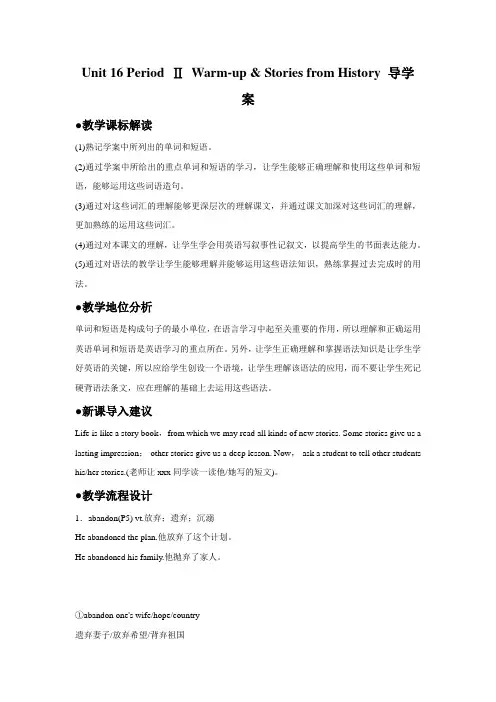
Unit 16 Period ⅡWarm-up & Stories from History 导学案●教学课标解读(1)熟记学案中所列出的单词和短语。
(2)通过学案中所给出的重点单词和短语的学习,让学生能够正确理解和使用这些单词和短语,能够运用这些词语造句。
(3)通过对这些词汇的理解能够更深层次的理解课文,并通过课文加深对这些词汇的理解,更加熟练的运用这些词汇。
(4)通过对本课文的理解,让学生学会用英语写叙事性记叙文,以提高学生的书面表达能力。
(5)通过对语法的教学让学生能够理解并能够运用这些语法知识,熟练掌握过去完成时的用法。
●教学地位分析单词和短语是构成句子的最小单位,在语言学习中起至关重要的作用,所以理解和正确运用英语单词和短语是英语学习的重点所在。
另外,让学生正确理解和掌握语法知识是让学生学好英语的关键,所以应给学生创设一个语境,让学生理解该语法的应用,而不要让学生死记硬背语法条文,应在理解的基础上去运用这些语法。
●新课导入建议Life is like a story book,from which we may read all kinds of new stories. Some stories give us a lasting impression;other stories give us a deep lesson. Now,ask a student to tell other students his/her stories.(老师让xxx同学读一读他/她写的短文)。
●教学流程设计1.abandon(P5) vt.放弃;遗弃;沉溺He abandoned the plan.他放弃了这个计划。
He abandoned his family.他抛弃了家人。
①abandon one's wife/hope/country遗弃妻子/放弃希望/背弃祖国abandon oneself to 沉溺于……;纵情于……②abandoned adj.被遗弃的;抛弃的;自我放任的Don't abandon yourself to despair,we'll help you.不要陷入绝望,我们会帮助你的。
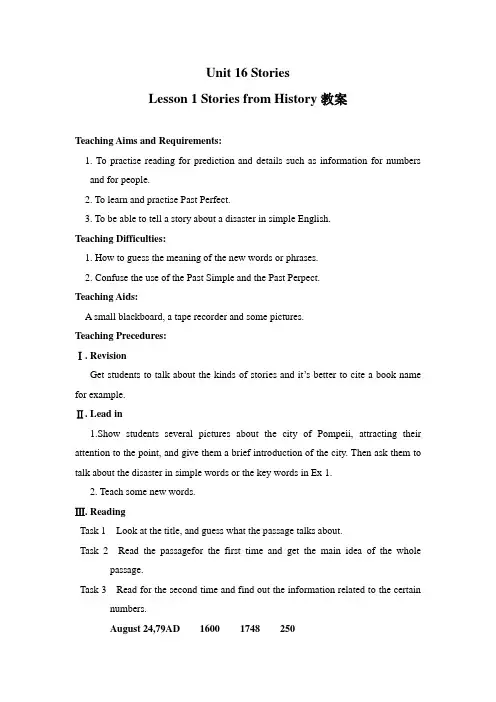
Unit 16 StoriesLesson 1 Stories from History教案Teaching Aims and Requirements:1. To practise reading for prediction and details such as information for numbersand for people.2. To learn and practise Past Perfect.3. To be able to tell a story about a disaster in simple English.Teaching Difficulties:1. How to guess the meaning of the new words or phrases.2. Confuse the use of the Past Simple and the Past Perpect.Teaching Aids:A small blackboard, a tape recorder and some pictures.Teaching Precedures:Ⅰ. RevisionGet students to talk about the kinds of stories and it’s better to cite a book name for example.Ⅱ. Lead in1.Show students several pictures about the city of Pompeii, attracting their attention to the point, and give them a brief introduction of the city. Then ask them to talk about the disaster in simple words or the key words in Ex 1.2. Teach some new words.Ⅲ. ReadingTask 1 Look at the title, and guess what the passage talks about.Task 2 Read the passagefor the first time and get the main idea of the whole passage.Task 3 Read for the second time and find out the information related to the certain numbers.August 24,79AD 1600 1748 250Task 4 Read for the third time and find out the information related to the certain persons.Pliny some scientists tourists one person who is prayinganother person who is trying to get upTask 5 Understanding of the whole passageCheck the students’understanding of the whole passage by answering the following questions:1. What is the article about?2. Why does the article describe Pompeii as a “ time capsule ”?3. Who wrote about the eruption of Vesuvius?4. What had Pompeii been like before the eruption?5. What can you see if you walk in the streets of Pompeii today?Task 6 True of False?1. Pliny’s uncle died in the terrible volcanic eruption in Pompeii.2. Pompeii’s ancient architecture,statues,decorated walls and so on impressed thepeople today most.3. When the volcano erupted, the peole in Pompeii were all praying.4. Every year many visitors came to Pompeii to dig out the ancient city and learnabout the ancient world.Ⅳ. Paraphrase1. He had witnessed as a young man…2. The eruption had occurred on August 24th, 79AD.3. The earth began to tremble and a volcano…4. He described a cloud coming down the mountain, blocking out the sun and burying everything in its path.5. Time rewinds.6. You can admire the ancient architectures, statues, decorated walls and authentic objects characteristics of the time.7. One person, sitting alone, looks like he is praying.8. One can only feel sorry and deep sympathy for these once-living statues.9. The city lives on nearly 2,000 years after its loss.10. Time capsuleⅤ.Oral PracticeSummarize the whole passage and get students to retell the story about Pompeii with the help of the information related to the certain numbers and persons.Ⅵ. Go through the grammar focus: past perfect tense ( If time permits )1. Introduce past perfect tense by giving several sentences from the text.2. Give some extra examples with some time adverbs.3. Ask students to do an oral practice for past perfect tense --situationHenry, from London, married Anna from Poland.He once told a reporter that he had never been in love until he met Anna.Suppose you were Henry, what else would you like to say to the reporter?Visit Poland…fall in love with a girl…eat Polish food…want children…spend all his time on one person…talk so openly…Ⅶ.Summary and Homework1. Sum up what we learned in this period briefly.2. Do the exercises on page 52 and 53.Pompeii: *He prayed. The writer toured Pompei in 1960.In modern Italy, Vesuvius is close to the large port city of Naples.。
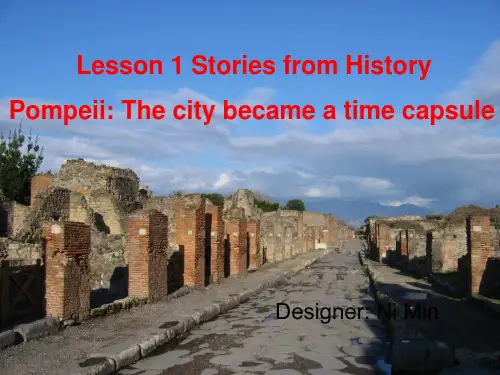
Lesson 1 Stories from HistoryTeaching Aim:Grammar: past perfect tenseRead for certain information, such as information for numbers, and for people.Stage 1 warm upShow students several pictures about the city of Pompeii, and give them a brief introduction of the city.Stage 2 reading for three timesa.look at the title, and guess what the passage talks about.b.Read for the first time and get the main idea of the whole passage.c.Read for the second time and find out the information related to the certain numbers.d.Read for the third time and find out the information related to the certain persons.Stage 3 understanding of the whole passagea.check the students’ understanding of the whole passage by doing exercise 2.b.Explain some of the difficult words and phrases from the text in English.c.Summarize the whole passage and treat it as an oral practice.Stage 4 grammar focus: past perfect tenseIntroduce past perfect tense by giving several sentences from the text.Give some extra examples with some time adverbs(时间副词).Stage 5 an oral practice for past perfect tense --situationHenry, from London, married Anna from Poland.He once told a reporter that he had never been in love until he met Anna.Suppose you were Henry, what else would you like to say to the reporter?Visit Poland…fall in love with a girl…eat Polish food…want children…spend all his time on one person…talk so openly…Stage 5 exercises on page 52 and 53.。
Unit16 Lesson1参考学案Learning aims(学习目标):1) Learn the important words, phrases and sentence patterns in this passage.2) Foster the reading abilities of the students.Important and difficult point: (学习重点、难点)Help the students to analyze the long important sentences.Learning guide (方法引导):话题导入—读前准备—阅读训练—理解操练—信息提取Learning procedures(学习过程):Step1:Important words in this part1._________n.传纪2. _________n.想象(幻想)物3._______vt放弃,遗弃4. _________n.受害者5._________n.(评判)的标准6. _________n.(长篇)小说家7. _________vt.保护,保存8._________vt.目击9._________vi发生10.________vi颤抖,发抖Step2:Important phrases in this part1._____________出现2.konck sb. over_____________3.____________从前4.____________火山爆发5.__________ 堵住从下面的例子中找出上面短语,划出并写出意思1. After a heavy rain, a rainbow will come into view in the sky.________2. Miss Lin was knocked over by a car.___________3. As we all know, black clouds can never block out the sun.__________Step3:Lead inWhat kind of stories do you like best? Can you tell them in English?Prepare them. ___________________________________________________________Step4:Read the passage in Lesson1 fast, and try to find the answers to the following questions.1. Question: Who wrote about the eruption of Vesuvius?_________________________________________________________2. Question: How did Pliny describe the cloud?________________________________________________________3. Question: Why do we call Pompeii a “time capsule”?_________________________________________________________Step5:Read the passage again, slow down and carefully, then answer the questions.1. Question: What is the article about?____________________________________________________________________ 2 Question: What had Pompeii been like before the eruption?____________________________________________________________________ 3. Question: What can you see if you walk in the streets of Pompeii today?____________________________________________________________________ Step6. Language pointsPara.11. Around the end of the first century AD, a Roman writer called Pliny wrote about a terrible volcanic eruption that he had witnessed as a young man.译文:______________________________________________________1)在本句中that引导的是________从句,that在从句中做_____语,能∕不能省略?2)从句的动作发生在主句谓语动词之前,因此,从句用_______时态.2) witness vt.________汉译英:①我目睹了那次交通事故.__________________________②我们见证了家乡的巨大变化.____________________________________2. The eruption had occurred on August 24th, 79AD.occur vi_________ 同义词________ 都有/无被动?思考: occur, happen, take place的区别_____________________________________________________3. Pliny described a cloud coming down the mountain, blocking out the sunand burying everything in its path, including whole villages and towns.。
Unit16 Lesson 1 Stories from HistoryTeaching PlanTeaching Aims:1)Knowledge-oriented aims:To master the new words and important phrasesTo understand the long and complicated sentencesTo understand the features of narrative writingTo learn the history and culture of Pompeii2)Ability-oriented aims:To improve the students’abilities of predicting and finding the detailed informationTo cultivate the students’ spirit of cooperation and imagination3)Emotion-oriented aims:To stimulate the students’awareness of protecting the environment and city cultureTeaching Important and Difficult Points:Important Points:How to grasp the main ideas of the text and each paragraphHow to find the detailed and effective informationDifficult Points:How to comprehend the text quickly and clearlyHow to encourage the students’imagination and improve their ability of organizationTeaching methods:1) Communicative Approach2) Learners-Centered3) Task-Based4) Interaction5) Autonomous learningTeaching Procedures:Step 1: Lead-inUse the gift of a bottle full of “capsules” the teacher got on the Teachers’ Day. The capsules aren’t real, but filled with small notes where the students wrote some best wishes to their teacher. Through this gift, the teacher explains the word “capsule”to them and thanks them for the “Love Capsules”, which preserve their love and wishes to their teacher. After students’ interest stimulated by this story, lead them toanother story of capsule-----Pompeii, The city that became a time capsule. Ask students to guess the meanings of “time capsule” and the title but check the answer later in the text analysis.Step 2: Pre-readingAlthough most students have heard the name of Pompeii, not all of them are familiar with the history and culture of Pompeii. So students are asked to make some prediction about this city through multiple choices exercises.1.How many years ago did Pompeii city exist?A. 1000 years agoB. 2000 years agoC. 500 years ago2.Which disaster destroyed the Pompeii city?A.earthquakeB. volcanic eruptionC. desertification3. Which country is Pompeii located in?A. In ItalyB. In ChinaC. In TurkeyStep 3: While-readingFirst-readingBased on the background information from the pre-reading, students are asked to read the text quickly to grasp the main idea of each paragraph and do the matching exercise. The tape will be played for the students to listen to the text. During listening, ask students to pay attention to the time markers in the text. Based on the main idea of each part, Ss are required to get the main idea of the whole passage.Para 1 Pompeii discoveredPare 2 Pompeii destroyed by the volcanic eruption Pare 3 Today’s PompeiiParas 4-5 Pompeii as a “time capsule”Para 6 Pompeii forgotten by the worldSecond-readingIn order to get a deeper understanding, Ss are required to read the text for the second time and answer the following questions.1. Who wrote about the eruption of Vesuvius?2. What had Pompeii been like before the eruption?3. What can you see if you walk in the streets of Pompeii today?4. Why does the article describe Pompeii as a “time capsule”?Third-reading(Pair-work)Ss read the text for the third time, knowing some detailed information about time, people and events, which are the typical features of narrative writing. First, students will be given some examples about finding information related to time and people. Then, they are encouraged to ask their partners questions according to the time and people and the partners find the correct information to answer. For example,1. What happened on August 24th, 79 AD?Event(Answer): The volcanic eruption occurred on August 24th, 79 AD.2. What happened to the people in the city after the volcanic eruption?Event(Answer): The people who had disappeared under the ashes were entirely forgotten by the world.HINTS:Time markers: at the end of 1st century AD; over the centuries; more than 1,600 years later; by 1748…People: Pliny; some scientists; tourists…Step 4: Post-reading (Summary)Through finding detailed information according to the time and people, Ss have got a good understanding of the whole text. In order to consolidate Ss’understanding, a summary will be given to them to help them review some words and expressions.Pliny was a Roman writer who had _________ and wrote about a _________ eruption which ________ on August 24th,79AD and it was of Mt. Vesuvius. The tragedy had left a deep __________ on Pliny. The whole city had been ______ under the ashes of Mt Vesuvius.By 1748, scientists had started to dig out the ancient city Pompeii. It is like a “time capsule”_________ buildings, objects and even the ___________ of people from theToday, people and scientists visit Pompeii every year to learn more about the________ world. In this way, the city, which the world had once forgotten lives on nearly 2,000 years after its ______.Step 5: Activity--- “Lesson from Pompeii” (Group-work)In addition to the story of Pompeii’s destruction, students are given more examples of today’s cities which are likely to disappear in the future by other natural disasters, such as the desertification, the sand storm or the rising of the sea level, using several pictures to show the serious situation of this kind of cities. Students are stimulated to protect the environment, to save these cities. So they are asked to design a public advertisement with the theme of “Lesson from Pompeii” to encourage more people to participate in protecting the environment and improving the city development.Step 6: Homework1). Make a theme exhibition in the classroom using the public advertisements designed in the activity of “Lesson from Pompeii”to heighten our environmental awareness.2)Read the text after class and memorize the new words and expressions. Writing design:Lesson1 Stories from HistoryPara 1 Pompeii discoveredPare 2 Pompeii destroyed by the volcanic eruption Pare 3 Today’s PompeiiParas 4-5 Pompeii as a “time capsule”Para 6 Pompeii forgotten by the world Teaching reflection:In this period, I divided the whole class into 14 groups , each of which contains students of different levels and arrange some tasks for them to fulfill. I laid my emphasis on the important of the Ss’ reading skills , as for the language points and text analysis , I will deal with them in the next period. In order to create an input-rich class, in the teaching process, I applied multi-media computer, courseware enlarge the input material and make the input material much more interesting, visible and comprehensible. Teacher should make correct use of courseware. Do keep in mind that courseware is just a helpful tool. Do never turn the class into an exhibition of the beautiful courseware.。